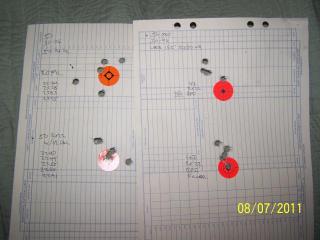
Originally Posted by
geargnasher

No, Bret, it's going faster. Now before you get freaked out by that, understand that it's all relative to time.
Take a trip with me on the back of a boolit, using some made-up but realistic numbers: You're drilling cull burros with a 220 Swift. Your muzzle velocity is 3000 fps, the twist is one in nine. The burro is two feet across. If you shot the burro point-blank at 3000 fps, the bullet would make 2-2/3 revolutions through the burro. Farther down range, your impact velocity is 2000 fps at, say 300 yards, but the rotational velocity is still a function of time, and is still turning practically the same amount of RPM, only velocity (distance traveled in a given time period) is LESS. Therefore, at 2000 fps, the boolit that was traveling at a rate of 4,000 rotations in 3,000 feet at the muzzle is now traveling at a rate of 4,000 rotations in 2,000 feet, and will be making one rotation in SIX INCHES instead of one rotation in NINE INCHES that it was at the muzzle. When the bullet passes through the burro, it will make four revolutions going through instead of the 2-2/3 it would have made at point-blank.
I don't know why this is such a difficult thing to get. Because math and me don't see eye to eye! If the barrel went all the way to a 300-yard target with the same twist the whole way, the boolit would have to be going the same forward velocity at the target as it was at the "muzzle" to make the same number of rotations in a given time period. In other words, for the boolit to be maintaining it's same rate of spin at the target that it does at the muzzle (which it essentially does), yet lose velocity (which it most certainly does, and a significant amount), the number of turns traced in a given amount of travel must increase.
Here's another analogy: A propeller on a small aircraft. Sitting on the runway with the brakes set and ready for launch, the prop is wound up tight at takeoff RPM, then the brakes are released and it begins to accelerate forward, maintaining the same RPM as the plane continues to accelerate down the runway. From the plane's perspective, the prop is turning the same speed the whole time, but if there were oil dripping off the prop blades as it went from a standstill to takeoff, the dripmarks on the runway would go from a puddle at standstill to ever-increasing sling marks, and at 150 mph the marks would be much more widely spaced than at 10 feet after launch.
If that doesn't click, how about this: oil is dripping at a constant rate from a leaky pan plug on you car 'cause the lube monkey you took it to for an oil change didn't replace the cracked Nylon gasket. The drip marks on the ground will be closer to each other at 5 mph than they will be at 55 mph. Agree? Of course they will be. The drip was a constant, the forward velocity was not. Same with boolits spinning in the air. If each rotation of a boolit was an oil drip, the drips will be closer together the slower the boolit goes, and as the boolit decelerates downrange, the boolit will be making more revolutions in a given distance, even though it's revolving at virtually the same rate (like the constant oil drip) as it was at launch.
The problem seems to be that some people have the concept that because twist rate and boolit rotation is fixed, it will be so along the entire boolit's path, just like tires on a car in contact with the road. Not the same thing. Here's what you're probably thinking: A tire will rotate at different speeds as the road speed changes, they are fixed to each other. As the car slows, so does the tire, and it doesn't matter if you go a mile at 100 MPH or a mile at one MPH, the tire will make the same number of revolutions. This is not the same thing as the oil drip or boolit in flight. Notice that if the tire makes a mile at one mile per hour, it is turning SLOWWWWW. If it makes the same mile in the same number of revolutions, but at 100 miles an hour, it is turning FAST. A boolit is rotating at the same rate whether going forward at 3000 fps or one fps, but the number of rotations it makes in a foot is much less in 3000 feet than of travel than it is in one foot of travel.
Gear




















 Reply With Quote
Reply With Quote














